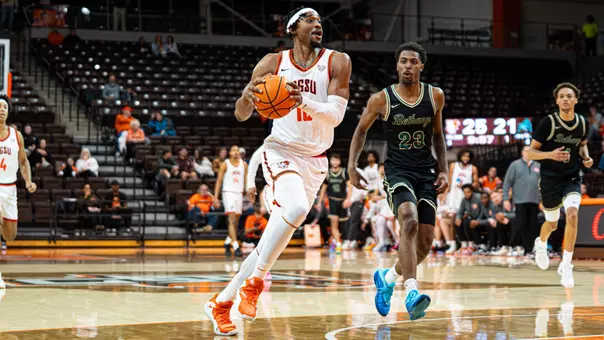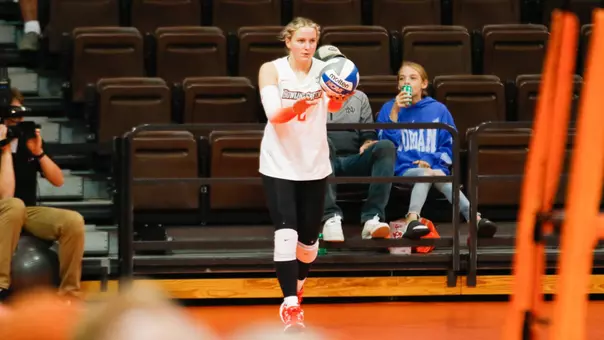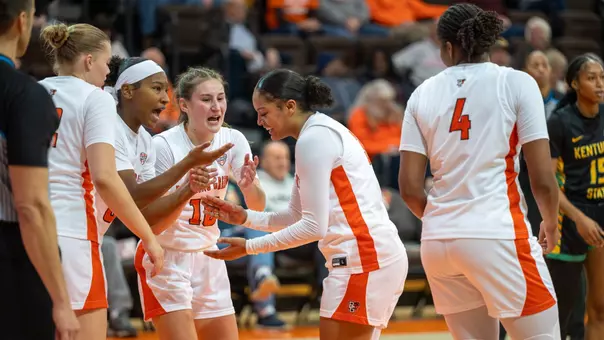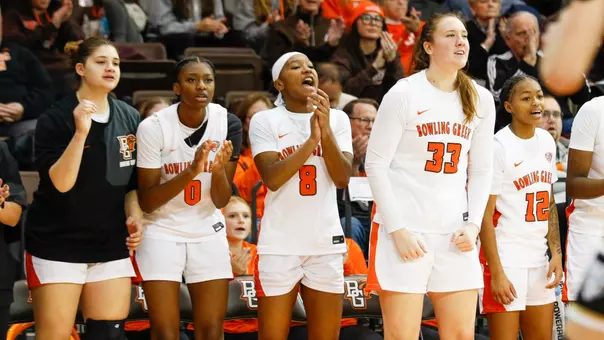Throughout the 2010-11 season, the BGSU Department of Intercollegiate Athletics will be celebrating the storied history of Anderson Arena, as we are 'Closing the Doors of the House That Roars' and preparing for the opening of the Stroh Center in the fall of 2011.
To submit a vote for the All-Anderson Team, to share your favorite memory of Anderson Arena or to keep up with the progress of the Stroh Center construction, Click Here. We will be sharing some of your fondest memories of Anderson Arena here at BGSUFalcons.com in the coming weeks and months.
The following article, written by Christopher Gross, appears in the Spring 2010 issue of Key Magazine. It is reprinted here with permission.
----
The looming orange-brick building with the gray paneled windows, which has sat on Bowling Green State University's campus for nearly 50 years as the school's home for basketball, has not much time left. Anderson Arena is dying.
But you need not feel sorry for the old building, for it has lived a good life. It was born as Memorial Hall in 1960, the same year John F. Kennedy was elected president and Cassius Clay won his first prizefight. The venue was given a second name in 1963, in honor of the Falcons' all-time winningest basketball coach, Harold “Andy” Anderson. Anderson won 66 percent of his games as Bowling Green's general, winning 367 in all before retiring after the '63 season.
Anderson Arena was once home to the dazzling tandem of Howard “Butch” Komives and Nate “The Great” Thurmond, one of the NBA's 50 Greatest Players. Coaching giants Bill Fitch, Guy Lewis and Jud Heathcote have all prowled its brown and orange sidelines. Heathcote, the man who led Magic Johnson and Michigan State to the 1979 NCAA championship, was involved in one of the building's more memorable games when he brought the Spartans to town in December 1990.
Michigan State, behind the All-American exploits of future NBA All-Star Steve Smith, was ranked fifth in the country and an early-season favorite to cut down the nets at that season's Final Four in Denver. But Bowling Green, who had beaten Michigan State the season before in East Lansing in the Spartans' first-ever game at the Breslin Center, as well as Kentucky in Rupp Arena in '88, had other ideas. Earning the reputation of giant killers under then-head coach Jim Larranaga, the Falcons backed down to no one, especially not inside the hallowed walls of Anderson Arena, where the men's basketball program has a lifetime winning percentage of nearly .750.
Bowling Green wasted no time introducing Heathcote and his Spartans to the Falcons' sweltering and thunderous gym, burying triple after triple and dunk after dunk in a hammering of one of the nation's elite teams. Before a sold-out crowd of 4,898, Anderson's largest showing since the arena's capacity was reduced due to bleacher renovations in 1983, the Clinton Venable-led Falcons blitzed Michigan State with a stifling man-to-man defense till the end, winning 98-85.
“We blew 'em out of the gym,” said Van Wright, assistant to the vice president of University advancement and unofficial Anderson historian. “Right from the tip-off, we had them beat. It was unbelievable.”
The game's curtain call came early in the second half, when Michigan State's Matt Steigenga, a hefty 250-pound-plus power forward, got loose on his team's own baseline and rose for a crushing slam. Before he could put the ball through the cylinder, however, Steigenga saw the outstretched left hand of Falcon center Tom Hall wrap from out of nowhere and punch the ball off the backboard. After caroming out to mid-court, the ball fell into the hands of the snake-quick Venable for a breakaway score.
“It's over!” Wright remembers howling from his Anderson seat after Venable punctuated the play.
Wright believes that night to be the loudest and wildest Anderson's raucous confines has ever been, and added that, as Venable was carried away above a sea of brown and orange, the building was so electric it felt like it was shaking on its foundation.
“The craziest ending to a game I've ever seen,” he said. “There were hundreds rushing the court and jumping around. It stayed like that well after the teams had left for their locker rooms.”
After the game, Michigan State's coach was visibly shaken and red as a bloomed rose, but not at a loss for words. Inside the cramped and musty classroom in Anderson's upper level corridor that has served as the arena's makeshift media center since the days Harold Anderson roamed its halls, Heathcote stammered and sulked.
“I'll tell you this,” the coach famously snarled, “I will never bring my team back in here.”
That was nearly 20 years ago, and Michigan State, a decade and a half after Heathcote's retirement, has yet to return to the “House that Roars.”
Wright is among the scores of fans over the decades who have come to Anderson Arena to see their first basketball game, and with it they consumed a wholesome taste of sporting Americana and gymnasium grandeur. Wright was there for the building's opening night, on December 1, 1960, when the Falcons took on Hillsdale College before a sold-out crowd. At about five years of age, Wright saw Bowling Green win that night, 79-45, and lay the foundation for what would become one of the most feared places to play in all of college basketball over the next 50 years.
His story is one that has been retold a hundred times over. People like Wright, who in the 1950s and '60s were forced to listen to word pictures of their heroes through the grainy voices of radio, were awed by their first trip inside Anderson's wondrous gym. Chilled by the boom of a crowd so loud it caused their wooden seats to tremble. Enamored by mezzanine handrails so bright with orange paint they weren't touched for fear they were still wet. Drawn to the fizzle of soft drinks
and the smell of pizza and popcorn that filled the building's halls. Captivated by the bellow
of PA announcer Jim Hoff during soaring player introductions so dramatic they took
on a holy tenor.
In those days, before the start of each game, the arena would fade to complete darkness, and an imposing spotlight would line up with the hallway entrance leading back to the teams' dressing rooms. When the Falcons' starters ran onto the floor, especially the greats, the Komives and the Thurmonds and the Walt Piatkowskis, Anderson screamed so loud it seemed to sway.
“Every game was like that back then,” Wright said. “Each game more exciting and louder than the last. It was an amazing time.”
Resting in the towering shadow of Jerome Library for almost half a century on the University's east campus, Anderson has seen its fair share of amazing performances and you-had-to-be-there-to-believe-it endings.
On February 16, 1963, in one of the last games Harold Anderson ever coached inside this arena, Bowling Green hosted the Loyola Ramblers. Loyola was one of the top teams in the country, and would later be crowned national champion under the guidance of their legendary coach, George Ireland. But on that night, the ghosts that would later wander Anderson Arena were born.
“I knew we were in trouble when we walked into the arena at 5 o'clock and the place was already packed,” Ireland said years later. “It was three hours before the game and they were cheering."
Behind the dynamic All-American duo of Thurmond and Komives – Thurmond with his penchant for intimidating defense and Howard with his flair for vicious crossovers and 25-footers – BG delivered the first of what would become many slayings of national powers inside Anderson over the years, whipping Loyola 92-75. Since then, one could write a fairly sufficient chapter of college basketball history based entirely on events that Anderson has seen, events so cherished they are told like scripture in northwest Ohio.
The 50 points Komives dropped on Niagara in '64, and the 49 he handed Western Michigan as an encore six nights later. Kirk Whiteman's 35-foot prayer to take down Toledo. The nine threes Jay Larranaga dropped on Akron. The Derek Kizer tomahawk dunk from the free throw line with a defender draped on his back. The track meet with Otis Birdsong and the top ten-ranked Houston Cougars in the '70s, in which Bowling Green ran to a 121-101 win. Matt Otto's rainbow three as time expired to tie Ball State in '94, completing a furious seven-point Falcon comeback in the final 45 seconds; then Shane Komives' jumper at the buzzer to end the game in overtime.
It is said the truly great buildings on earth do live, that their walls do talk. The St. Patrick's Cathedrals and the Fenway Parks and the Cameron Indoor Stadiums are all living proof that places have emotions too, that blood does run through their beams and moments of wonder do summon their spirits. Anderson Arena is one of those sacred venues. Five decades of basketball have passed through its concrete partitions, and inside them have come some of the most revered names the game has ever known. Some have never left.
“You can just feel it,” said Joe Sharp, who has known the building better than anyone since 1979, the year he became Falcon basketball equipment manager. “Walking into Anderson is like walking into the gym down at Duke. That feeling of all the great players and all the great games is there.”
The ghosts that watch over Anderson Arena's ancient floor might best explain what happened there on Valentine's Day 1996. The game, known affectionately to Falcon fans as the “Trip from Above,” is widely regarded as the best the arena has ever held.
It was Antonio Daniels' junior season, and the game was against nationally ranked Eastern Michigan. Daniels, who would later graduate from Bowling Green as a top-five pick in the 1997 NBA draft, was mourning one of the greatest losses he would ever face. Earlier that week, his brother Chris had suddenly collapsed and died after suffering a rare form of heart failure. Daniels was playing in memory of his fallen brother and friend.
But Daniels had more than just the memory of his brother on his side that night against Eastern Michigan. The poltergeists that inhibit Anderson's spooky recesses, protecting the home team in moments such as these, were there, too.
With just seconds to play and a tied game hanging in the balance, Daniels held the ball between the circles out top, watching the clock, waiting to make his move. Defending him was Earl Boykins, a future All-American, and already one of the best defenders in college basketball. As the clock read five seconds to play, Daniels pounded the ball on the floor, driving right. Boykins was eyeing him like a seasoned thief. Boykins, a 5-foot-5-inch burst of energy, had shadowed Daniels the entire game, pestering him with limbs as nimble as a rabbit's.
As Daniels made his final plunge toward the basket, the poltergeists awoke from their slumber. Boykins tripped over his own feet. Perhaps the quickest and best on-ball defender to ever lace his sneakers in the Mid American Conference had fallen flat on the floor, on his team's most important defensive possession of the game. Daniels strolled to the easiest bucket of his career. A walk-off layup as the horn wailed. The ghosts had done it again. Harold Anderson or Butch Komives had floated down from the banners above and mischievously stuck out a leg, clearing room for one of their own.
“The place has an aura,” Wright said of Anderson. “When you walk in there, the history just surrounds you.”
There is a mystique to Anderson Arena that is felt in few sporting venues across the nation. There's a reason college hoops broadcasting legend Dick Vitale once called the building “the top arena in college basketball.” Its luster might be long gone and its air now a little fusty, but Anderson has never lost its character. The building has remained the quirky and boiling hot basketball barn it's been since it opened half a century ago, nobody ever caring enough to refurbish it, but also nobody willing to let it go.
The best seats are the best in basketball, seats so close to the court that, as former Marshall standout J.R. VanHoose once put it, “the fans can pick the hair off your legs.” The worst are up in the balcony's far corners, where the rafters graze visitors' heads and banners obstruct sight lines. It has remained without air conditioning for as long as it has lived, leaving for a vulgar stench of hot dogs and sweat in the air on game nights. Because of this, the arena's upstairs windows remain open all year long, resulting in an echoing chorus of cheers that blows across campus on game nights. The once bright orange shine on handrails has flaked away and green spots of mold can be found growing on walls. There are dead spots on the floorboards where bouncing balls go to die. The restrooms are lined with olive linoleum floors, and coaches' offices are adorned with chipping wooden doors.
The bleachers on the arena's east side are the same lumber risers that Bowling Green students used to shake in the good ol' days, when Komives was lofting another ball for Thurmond to crush through the iron. The Anderson Animals, as the arena's student section later came to be known, are the Midwest's answer to the Cameron Crazies at Duke, a chaotic bunch that has crammed Anderson's floor-level student section to the edge since the gym was taking its first steps. On the nights of big games, this section of Anderson becomes a fire marshal's worst nightmare, with way too many crazy kids in face paint, wigs and orange tie-dye packed into the wobbly old set of bleachers. But Bowling Green's marshal won't say a word, not when MAC titles are on the line – and never when Toledo is in town.
In the arena's heyday, games at Anderson Arena were more than just two-hour blocks of basketball. They were social events. Not only did loads of students fill the courtside bleachers each night, but also droves of townspeople, overall-clad farmers and all sorts of unique characters stuffed the upper deck to its peak. Falcon basketball was like attending church. Games at this basketball cathedral were not missed.
“In the winter, Anderson was the place to be,” said Bill Blair, who spent 18 years of his life as the voice of Falcon basketball in the 1960s and '70s on WAWR Radio. “Game nights were events in those days. During the game the crowds were loud and rowdy. Then afterward, they would hit parties all up and down [Wooster Street].”
Anderson Arena has never been just about Falcon basketball. It's not just Thurmond and Komives and Daniels who played in front of the building's deafening masses. It is the world famous Harlem Globetrotters and Aerosmith, Jefferson Starship and Bob Seger, Gerald Ford and Ronald Reagan. British rock-and-roll royalty Foreigner delivered its first concert on North American soil inside this building's walls.
A part of Anderson's history with which many aren't familiar is that the building was once the practice home of Bowling Green football, back before the days of Doyt Perry Stadium, when University Field still sat on central campus outside Anderson's front doors. Back before Anderson was built, in the first half of last century, one could have found football greats Woody Hayes and Ara Parseghian roaming the same soil on which the arena now sits. After it was constructed, Anderson became a place for winter training and indoor refuge for the gridiron boys when the spring rains came.
The home locker room area in Anderson Arena, apart from a facelift here or there over the past several decades, has as much history to it as any spot in the building. It is within this consecrated space that legendary Falcon head football coach Doyt Perry delivered his powerful pregame speeches and chalked passing routes on blackboards when the team used the arena as a locker room from 1960 to 1964. Meadowlark Lemon and Marques Haynes of the Original Harlem Globetrotters dressed inside these walls. During a visit to Bowling Green in 1976, Gerald Ford was rushed here after one of the great scares in American history involving one of our presidents.
While Ford was in the middle of a speech, a sudden series of small explosions not unlike the rapid discharge of gunshots erupted throughout Anderson. Fearing for the president's life, Secret Service agents hurried Ford into the same hallway entrance Nate “The Great” once passed through on game nights and into the Falcons' locker room. As it would turn out, the gunshots were actually the result of an instamatic camera bulb that had burst.
When the final game is played there sometime in the spring of 2011, and the doors are officially closed for good, Anderson Arena's walls are surely going to scream. Not screams of bitterness toward the state-of-the-art Stroh Center across campus that will take its place, but screams of memory. For it is the memories – the legendary performers, speeches from world leaders, great games, howls of the crowd, scents of popcorn and must, spilled soda on sticky floors, oddities of random coloring schemes and structural flaws – the arena will be remembered by. Over 1.6 million have passed through Anderson's turnstiles. There is an entire generation of people who have grown up with the building since its very beginning, who have matured with it and shared in its most significant achievements.
“I'll be sad when it's gone,” said Joe Sharp, who remembers shooting buckets on Anderson's court as a kid with Nate Thurmond and Howard Komives while tagging along to work with his father, the building's original equipment manager. “I've been in the building since I was six years old.”
Anderson Arena is more than just an aging building that has passed its prime. To appreciate the building's finer majesty, one must look past its decaying foundation and disregard for modern amenity. It is a throwback to a different era, to a time when lightless ballparks still filled the major leagues and field houses with timber seats still dominated basketball. The intimacy and old-world feel that overcomes visitors when walking through Anderson's archaic halls and sitting in its upper reaches is unmatched by newer, commercial arenas. When the crowd is at its height, after a late-game triple has caught nylon or an elevating slam has dizzied the backboard's support, Anderson roars like the old Boston Garden, which somewhere from the basketball afterlife, wishes it still could.
When the Stroh Center, which, with its fancy air conditioning, marbled floors and lavish team store, will certainly be no blood relative of Anderson's, is finally complete, Falcon basketball will have to find a new home court advantage. Because the building it is leaving behind on East Ridge Street, the one that rests on the footsteps of some of the most legendary figures the world has ever known, is irreplaceable. The “House that Roars” is one of the last great basketball monuments left, and, when it passes, so will have an important piece of the city of Bowling Green.
Closing the Doors of the House That Roars page
Submit your nominations for the All-Anderson Team
Submit your Anderson Arena Memories
Follow the latest Stroh Center News



%20(2).png&type=webp)









